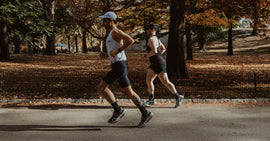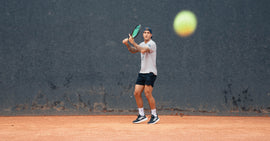Whether you're training or competing in an important event, proper nutrition and hydration are essential pieces of the puzzle. It's common to make mistakes with the timing and consumption of food and drinks. These mistakes can result in a range of negative consequences, from gastrointestinal discomfort to simply not having enough energy to complete that workout or race.
To help avoid this issue, I’ll go over some guidelines that highlight important tips on how to time your nutrition before, during, and after a workout or competition. Of course, everyone is different, and what works for some may not work for others. So, as always, it’s crucial that you become your own experiment and learn what works best for you. Let’s dive in!
Pre-Workout
-
Eat and Drink Beforehand
For longer workouts lasting 2 to 3 hours (or more), it’s crucial to have a complete meal that leaves you feeling satisfied and full before starting your workout, and to drink enough water. Ideally, this meal should be consumed 3 hours beforehand. This ensures that the food is fully digested and absorbed, and that your blood sugar levels are stable, which is very important. Eating a meal causes blood sugar to rise. This, in turn, causes insulin to be released about 60 to 90 minutes later, transferring sugar into muscle and fat cells. If you start exercising 60 to 90 minutes after a meal, you’re beginning the exercise exactly when insulin peaks. Since contracting muscles can absorb sugar without insulin, the combination of insulin and exercise can cause blood sugar to drop, making you feel weak and experience an “energy crash.” So, plan enough time to eat, digest, hydrate, go to the bathroom, and stabilize your blood sugar beforehand. -
Eat and Drink Right at the Start
It’s not always possible to have a full meal 3 hours before your workout, especially if you're an "early bird" training first thing in the morning. If that's the case and you're concerned about not having enough energy for an intense workout, start eating and drinking right at the beginning of your session. This is possible during exercise because, unless you're working at a very low intensity, insulin is generally not released when we're exercising, as the muscles in use can absorb sugar without it. This means that if you eat as you start exercising, you won’t experience the drop in energy that can happen when you eat too much just before your workout. It's common to see athletes consuming simple sugars at the starting line. In addition to food, it's also common to drink a high-sodium solution, such as Power Powder Z2+ Lime Zest (with 750 mg of sodium per serving), right before intense and/or long workouts, especially in hot conditions (as is common here in Brazil). It will provide you with energy (from carbs) and the necessary hydration. Note: Be careful! Drinking too much at the start, especially if it's cold or when the exercise intensity is low, will probably just make you need to pee 20 to 30 minutes into the workout. -
Just Get Up and Go
In some cases, if the workout is not too difficult or long, you might simply exercise on an empty stomach right when you wake up. During sleep, the body undergoes an overnight fast that resets its hormonal and metabolic environment, keeping blood sugar stable despite the lack of food. You can take advantage of this by simply getting up and starting your workout, and then having breakfast afterward. This works especially well for low-intensity aerobic exercises, where fat is the primary fuel source. For longer, more intense workouts, however, carbs are the quickest and most efficient energy source.
During Workout
During a workout, the amount of supplements, water, and sodium needed will depend on a variety of factors, including your fitness level, exercise intensity, duration, and the weather. Given all these possibilities, understanding your body is key. With that in mind, here are some general ideas to guide you:
-
Hydrate First, Fuel Later
In most situations, thirst is a greater concern than “hunger,” especially during exercises that make you sweat a lot. When it's hot and the intensity is high, it’s more likely that the liquid and sodium we lose through sweat will negatively impact performance before fuel reserves are depleted. Carbohydrate and sodium solutions (like Power Powder) can actually hydrate better than just water while also providing fuel. This is because active transport of sugar and sodium helps accelerate water movement through the small intestine into the body. There are few situations where drinking only water is better than using a mixture of carb and sodium drinks. In general, replacing at least half of the calories burned per hour and keeping dehydration below 3-4% of your body weight will keep you properly hydrated and fueled for most workouts! -
Don’t Wait Until You’re Thirsty to Hydrate
Often, waiting until you’re thirsty to drink is already too late, and you may be too dehydrated to fix it. One of the key signs of thirst is an increase in blood sodium concentration. As we sweat and lose more water than salt, sodium concentration in the blood rises, making us feel thirsty. If we drink only water, we don't need to drink as much as we lose because we also lose a significant amount of sodium in sweat (600 to 1,500 mg of sodium per liter of sweat). This means that with just water, we often quench our thirst before we've fully replaced the water we lost. Thirst controls sodium balance, not water balance. And this thirst mechanism is actually a good thing, because while water loss can harm exercise performance, disturbing sodium balance can harm life in general. It’s essential to replace the water and sodium lost in sweat, as keeping sodium balance under control takes priority over water balance. That being said, if you weigh yourself before and after exercise to track water loss and consistently find that you're 3 to 4% dehydrated, it could be that the volume of water alone isn't the problem. If you wait until you're thirsty to drink, you may not be consuming enough sodium.
Post-Workout
During exercise, our muscles suffer micro-injuries, right? And what do we want? To repair those injuries. Therefore, it's important to eat and hydrate as soon as possible after exercise. Here are a few tips to help with that:
-
Plan Ahead
This is certainly not the easiest or most convenient thing to do. The reason for this is that immediately after exercise, fatigued muscles are very sensitive to insulin. This means that when insulin is released as you eat, the energy from the food you consume is preferentially delivered to the muscles that need it the most, rather than being spread throughout the body to fat cells or muscles that weren’t active during exercise. The result is more effective, targeted, and faster recovery. -
Use a Recovery Drink
With the hustle and bustle of work, life, and routines, we know that we don’t always have the necessary foods on hand—like sources of protein and carbohydrates. Ampli, our post-workout drink, was designed exactly for this. It provides 2 parts high-quality protein to 1 part fast-absorbing carbohydrate, along with Type II collagen and an excellent mix of vitamins and minerals, kick-starting your recovery process and helping to amplify (as the name suggests) your next meal.
It’s a great way to re-fuel and rehydrate until a more substantial meal can be prepared.
The timing of your meals around physical activity is a great way to structure your daily nutrition and reach your goals. After all, thinking of food as fuel and recovery fosters a healthier relationship with what we eat. Our bodies are designed for physical activity, so use food in service of that. It will nourish you, provide energy, and optimize your recovery. Lastly, as a "nutrition tip," increase your calories during workouts and decrease them when you're not exercising.
Regardless of the intensity, type, or duration of exercise, thinking about how we time our food in relation to physical activity is crucial for a healthier and more sustainable life.


